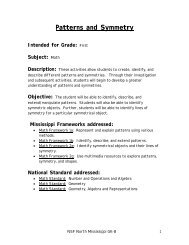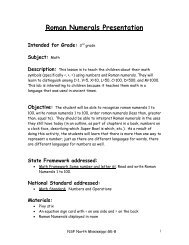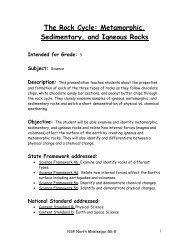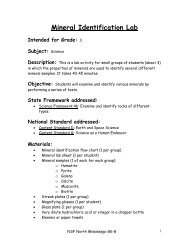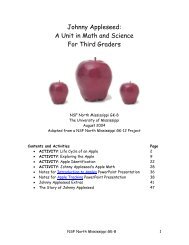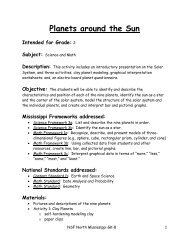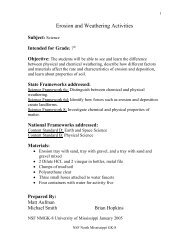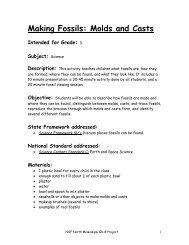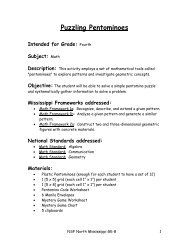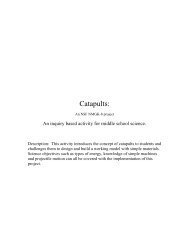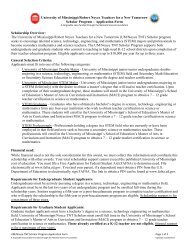GK-8 Project Submission Form - The Center for Mathematics and ...
GK-8 Project Submission Form - The Center for Mathematics and ...
GK-8 Project Submission Form - The Center for Mathematics and ...
- No tags were found...
You also want an ePaper? Increase the reach of your titles
YUMPU automatically turns print PDFs into web optimized ePapers that Google loves.
f. To draw the orbits, have someone st<strong>and</strong> in the center (where the sunwill be) <strong>and</strong> hold one end of the yarn. <strong>The</strong>n take the other end of theyarn out to the appropriate distance <strong>and</strong> draw the orbit of the planetMercury by walking in a circle.g. Repeat this process <strong>for</strong> all nine planets, exp<strong>and</strong>ing the size of thecircle (the diameter) by about 4 or 5 feet <strong>for</strong> each additional orbit.(For the purposes of first graders, it is much easier to use circularorbits <strong>and</strong> simply place the orbits in the correct order, equally spacedfrom each other).h. Label each orbit with the correct planet name.i. Describe each planet to the students <strong>and</strong> tell about it’s relation to thesun.j. Explain Rotation <strong>and</strong> Revolution.k. Take the students to the designated area. <strong>The</strong> class will most likelyneed to be split in half, unless you have a very small class!l. Give 10 students one planet (or the sun) each <strong>and</strong> have them st<strong>and</strong> onthe correct orbit.m. Explain that first they will revolve around the sun. <strong>The</strong>y should walkslowly around the sun (staying on their respective orbits), making onefull revolution be<strong>for</strong>e stopping.n. Now explain that they will simulate rotating <strong>and</strong> revolving around thesun. To do this role play, they should spin slowly while also walkingaround the orbits.o. After they have finished this revolution, have the students st<strong>and</strong> intheir orbit <strong>and</strong> take turns describing where they are in relation to theother planets around them. (Ex: Earth is between Venus <strong>and</strong> Mars).6. At some point amidst these activities, discuss astronauts <strong>and</strong> astronomers.Talk about what astronauts <strong>and</strong> astronomers do, who can be astronauts ansastronomers, why there are astronauts <strong>and</strong> astronomers, etc. Explain thatwe still don’t know everything about space, but astronauts <strong>and</strong> astronomersare helping us figure it out. End this discussion by allowing students tosample astronaut foods such as freeze-dried strawberries.Evaluation: Students’ individual planet models will demonstrate theirunderst<strong>and</strong>ing of the relative size of each planet <strong>and</strong> the order <strong>and</strong> distance fromthe sun. <strong>The</strong> Students abilities to role play the planets <strong>and</strong> correctly describetheir planet’s location can also be used <strong>for</strong> assessment.Prepared by NSF North Mississippi <strong>GK</strong>-8 <strong>Project</strong> 9



